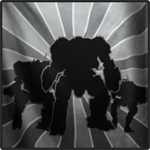Heh. 120mm? I'd say we should be looking at numbers like 500mm or larger.
Take a real-world tank cannon, say, Rheinmetall 120mm, the main gun for M1A1. It weights roughly 4.5 tons(barrel+mount), and a single shell of its weights no more than 25kg. Do a bit math, then you'll see that a ton of ammo should include 40 shells.
Now let's look at BattleTech autocannons. AC2 weights 6 tons with 75 shells per ton of ammo, and AC5 weights 8 ton with 30 shells per ammo. Considering that these guns will be mounted to 'mechs with muscle+bone like structures instead of hard chassis like a tank's, let's say that an autocannon needs about a extra half of its weight to house mechanisms to balance out recoil and such.
That means a real-world 120-ish caliber tank gun is placed somewhere between AC2 and AC5.
Then let's take another look at AC10 and AC20, and let your imagination fly about what caliber they would be

But again, the purpose of cannons in BT and real world are very different. Real-world tank guns are meant to penetrate, but judging from the few pieces of BT literature I read, it seems like Battlemech armors are expected to be melted instead of penetrated in battle. I could only assume that material technology in BT universe is so advance that armor simply cannot be penetrated, so instead you'll have to chew through the armor with sheer amount of explosives and momentum
And that would led to the birth of monstrous cannons like AC20, a cannon whose shell weights more than 100kg, packs so much explosive and is so not aerodynamic, that its momentum could last for only 270m.
Considering that, 500mm seems like a good assumption for its caliber.




















